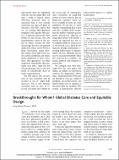Breakthroughs for Whom? Global Diabetes Care and Equitable Design
Author(s)
Moran-Thomas, Amy
Downloadnejmp1611475.pdf (208.0Kb)
PUBLISHER_POLICY
Publisher Policy
Article is made available in accordance with the publisher's policy and may be subject to US copyright law. Please refer to the publisher's site for terms of use.
Terms of use
Metadata
Show full item recordAbstract
M. s. L. showed me the empty container of test strips and a box with butterflies on it. They were for a glucometer model I’d never seen before, called a FreeStyle. She explained that the machine had been given to her a few years earlier by a student philanthropic group from Arkansas on a “medical mission” trip to her village in Belize. She’d also been given a 3-month supply of the costly testing strips the machine required, which she’d stretched for nearly a year. Then she ran out, and there was nowhere in Belize to get more strips. That was 2 years ago.
Date issued
2016-12Department
Massachusetts Institute of Technology. Anthropology ProgramJournal
New England Journal of Medicine
Publisher
New England Journal of Medicine (NEJM/MMS)
Citation
Moran-Thomas, Amy. “Breakthroughs for Whom? Global Diabetes Care and Equitable Design.” New England Journal of Medicine 375, no. 24 (December 15, 2016): 2317–2319. © 2016 Massachusetts Medical Society
Version: Final published version
ISSN
0028-4793
1533-4406